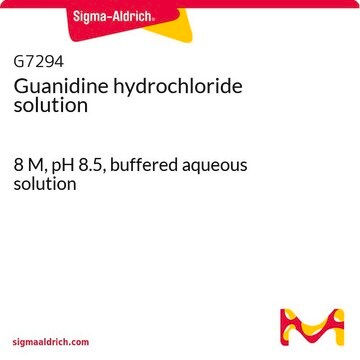SRE0066
Guanidinhydrochlorid-Lösung, 6 M
Synonym(e):
Aminoformamidinhydrochlorid, GuHCl, Guanidiniumchlorid, Guanidium chloride
About This Item
Empfohlene Produkte
Form
liquid
Qualitätsniveau
Konzentration
6 M
Anwendung(en)
diagnostic assay manufacturing
Lagertemp.
room temp
Verwandte Kategorien
Anwendung
Guanidinhydrochlorid wird in der Regel auch für die Isolation von RNA, zum Denaturieren von globulären Proteinen und für Proteinrückfaltungsstudien eingesetzt. Es kann auch zur Erleichterung der Erzeugung von tryptischen Peptiden zur Analyse von komplexen Proteinproben eingesetzt werden.
Physikalische Form
Hinweis: Wenn in dem 6 M Puffer eine Ausfällung vorliegt, erwärmen Sie die Flasche vor dem Gebrauch auf 37 °C und mischen den Inhalt, bis er vollständig gelöst ist.
Signalwort
Warning
H-Sätze
Gefahreneinstufungen
Acute Tox. 4 Oral - Eye Irrit. 2 - Skin Irrit. 2
Lagerklassenschlüssel
10 - Combustible liquids
WGK
WGK 1
Flammpunkt (°F)
Not applicable
Flammpunkt (°C)
Not applicable
Analysenzertifikate (COA)
Suchen Sie nach Analysenzertifikate (COA), indem Sie die Lot-/Chargennummer des Produkts eingeben. Lot- und Chargennummern sind auf dem Produktetikett hinter den Wörtern ‘Lot’ oder ‘Batch’ (Lot oder Charge) zu finden.
Besitzen Sie dieses Produkt bereits?
In der Dokumentenbibliothek finden Sie die Dokumentation zu den Produkten, die Sie kürzlich erworben haben.
Kunden haben sich ebenfalls angesehen
Artikel
A RPLC-MS workflow for mass analysis of reduced monoclonal antibody, trastuzumab, including reduction procedures, calibration, and system suitability tests.
A RPLC-MS workflow for mass analysis of non-reduced monoclonal antibody, trastuzumab, including calibration, and system suitability tests.
A complete reversed phase HPLC-ELSD workflow, including sample preparation for the analysis of Polysorbate 80 in a monoclonal antibody formulation.
Protokolle
SEC-MS protocol for rapid glycoprofiling of monoclonal antibodies with antibody purification and mass spectrometer calibration.
A complete workflow for the intact and middle-up mass analysis of reduced and non-reduced monoclonal antibodies based on SEC-MS with sample preparation by protein-A affinity clean-up.
Unser Team von Wissenschaftlern verfügt über Erfahrung in allen Forschungsbereichen einschließlich Life Science, Materialwissenschaften, chemischer Synthese, Chromatographie, Analytik und vielen mehr..
Setzen Sie sich mit dem technischen Dienst in Verbindung.




